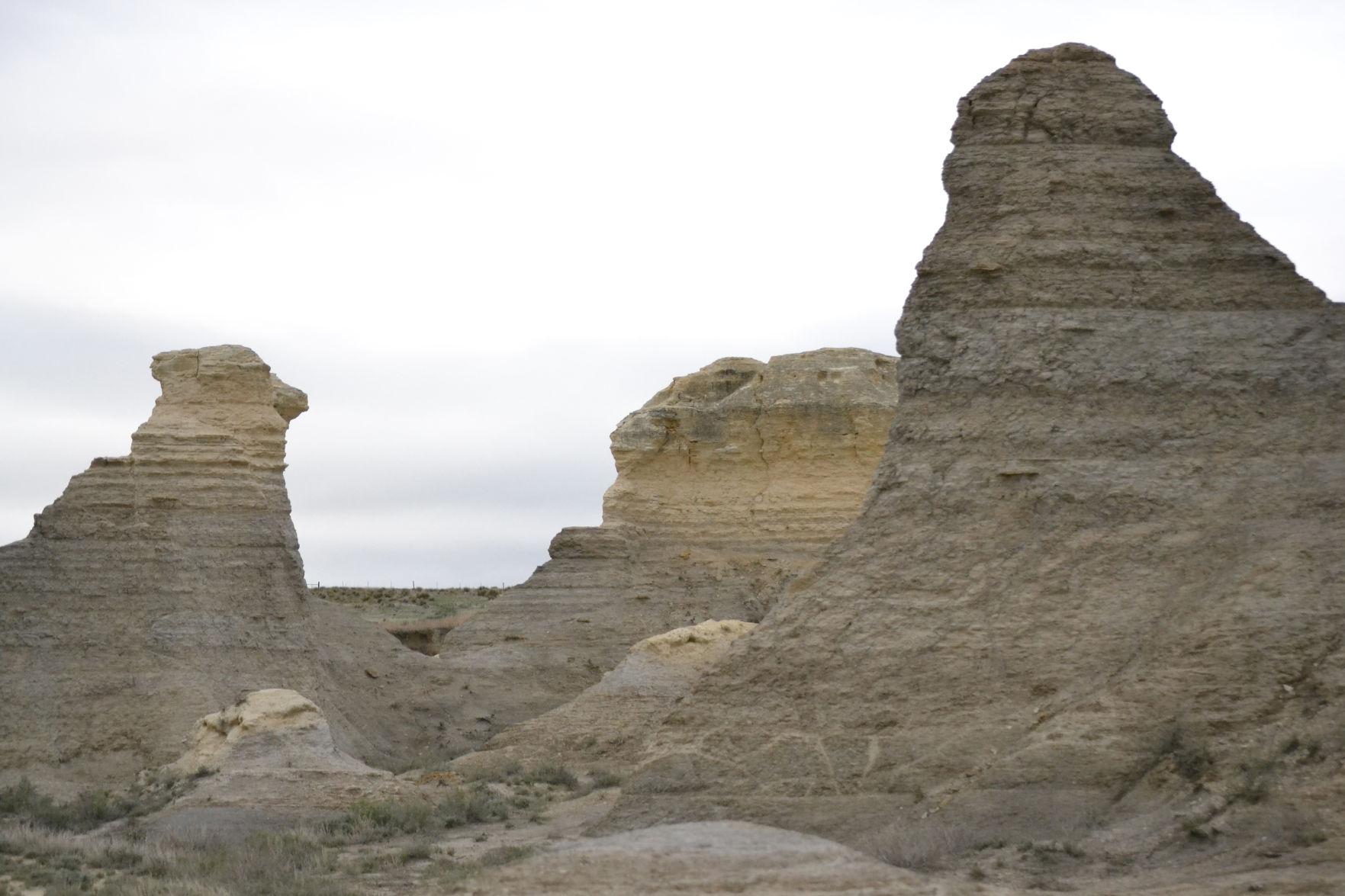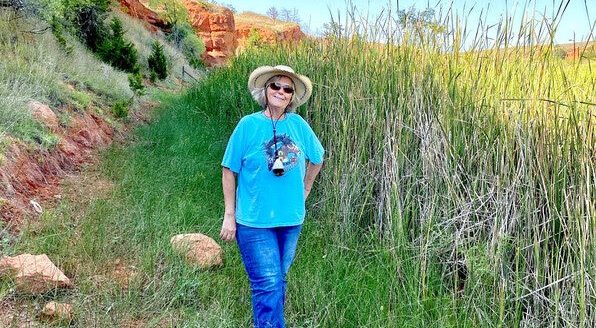Prairie preservation: New state park will expand conservation mission of historic ranch

Dramatic Niobrara Chalk bluffs and spires, millions of years old, stretch into the sky at the Little Jerusalem Badlands State Park, the newest state park in Kansas. Less conspicuous than the badlands, but equally impressive, are the diverse wildlife and plant species that make this chalk prairie and the surrounding grassland in Logan County their home.
The Nature Conservancy—a nonprofit environmental organization headquartered in Arlington, Virginia—and the Kansas Department of Wildlife, Parks and Tourism are partnering to preserve the rock formations and fossils at Little Jerusalem. They hope connecting visitors to the land will raise awareness about the importance of conserving this native shortgrass and mixed-grass prairie for generations to come.
The 17,290-acre Smoky Valley Ranch adjacent to the Little Jerusalem badlands is the primary conservation focus of Matthew Bain, who manages the Conservancy’s western Kansas conservation projects. The 300-acre badlands and Smoky Valley Ranch are located off U.S. Highway 83 about halfway between Scott City and Oakley, Kansas—west of Monument Rocks and north of Historic Lake Scott State Park.
In October 2016 the Conservancy purchased the badlands portion of the Little Jerusalem property from a fifth-generation cattle rancher, Bain said. The McGuire family had received other offers for the property but felt the Conservancy was best suited to preserve the land while allowing others to visit the badlands and enjoy them, he said.
Stewarding the native prairie
“Eighty percent of native prairie in this part of the state has been converted to some other use—primarily cropland,” Bain said. “Basically, the focus of the Conservancy in Kansas has been conserving what’s left of the native prairie—that 20 percent that’s left. And you can’t go about conserving that without ranchers, without ranching.”
He continued, “In Kansas the last grasslands are stewarded by ranchers, and that’s a very sustainable, very productive use of the land. Healthy wildlife populations and successful ranching can go hand in hand.
“Ranching really is critical for maintaining what’s left of our native prairie,” Bain said.
The new Little Jerusalem state park will continue to be a working cattle ranch. “Just like on the rest of the ranch, we use cattle as the primary tool to manage the grass,” he said.
The Smoky Valley Ranch takes in about 800 cow-calf pairs. The Conservancy also owns about 200 head of buffalo that make their home on the rangeland at the ranch.
“Really there are three things that shape and maintain the prairie: grazing, fire and—in this part of the world—drought,” he said. He noted the only one of those three ecological drivers they can use well in the western Kansas landscape is grazing. Although the Conservancy uses prescribed burning when possible, because of weather and drought conditions, it can’t depend on that every year.
Therefore, they focus on grazing management. “We use a rest-rotation grazing management system. We match our cattle numbers with the amount of forage that’s produced,” he said.
He said that on over 90 percent of the ranch, their conservation targets are to improve range condition, increase forage production and increase wildlife habitat. A small interior portion of the ranch is a reintroduction site for the black-footed ferret, one of the most endangered mammals in the United States. Prairie dogs, which are essential to the ferrets’ habitat and survival, are allowed on the remaining portion of the ranch so the conservation targets there are different.
Improving range condition and increasing forage
Bain said when conditions allow for it, they follow a patch burn grazing system. “When conditions are perfect, we follow a prescribed fire plan and will burn portions of the pasture.”
Bain said a fundamental part of their grassland conservation plan throughout the ranch is rotational grazing, which features a high-intensity grazing event for a relatively short period of time, then the animals are moved to a different fenced area.
He said this system mimics how the land was grazed historically when buffalo roamed the prairie in large numbers. Bain said science shows that the native plants are best adapted to that rest-rotation grazing pattern.
The soil on the chalk prairie doesn’t contain much topsoil above the chalk layer and thus isn’t suitable for annual crops, Bain said, but it’s ideal for forage. “It’s a Minnequa soil that produces 5,000 pounds of forage per acre and is incredibly productive for grass. It’s an important ecological site for forage production.”
Sign up for HPJ Insights
Our weekly newsletter delivers the latest news straight to your inbox including breaking news, our exclusive columns and much more.
The native rangeland feeds the multimillion-dollar beef industry in Kansas. Bain stressed it’s important for people and it’s also important for wildlife.
Increasing wildlife habitat
Ferruginous hawks require the tall columns at Little Jerusalem to raise chicks, and the badlands provide that specialized habitat, Bain said. The Say’s phoebe makes mud nests against the vertical structures, and rock wrens are unique to the area as well, he said. There are also different types of snakes and other reptiles that are common to the area in the rock crevices and fractures. The most common mammals on the ranch (other than cattle) are mule deer, and the rocks are important for their habitat too.
Native plants thrive in the chalk prairie as well. “Great Plains wild buckwheat is endemic to the chalk prairie and found nowhere else in the world,” Bain said. It’s rare as a whole, he said. But it’s plentiful on the ranch as the growing conditions help it thrive.
“Here we use conservation targets to manage for all that native biodiversity,” Bain said. On some parts of the ranch, the conservation target is prairie chickens.
The Conservancy’s focus on increasing forage provides ideal habitat for lesser prairie-chickens. A pasture’s short, residual grass provides good ground cover for the birds’ leks. Kansas State University has conducted research on lesser prairie-chickens at Smoky Valley Ranch. Researchers study how different grazing practices can improve habitat, and they document what works well.
“This place has been an important venue for study and finding solutions in a real-world ranching scenario that also works for something like the lesser prairie-chicken,” Bain said.
Building the state park
The Conservancy is responsible for managing livestock and conserving natural resources on the property, Bain said, and managing public access at the state park primarily will be the mission of KDWPT.
An opening date for the state park has not yet been set, but construction crews are currently at work building a parking lot in the southeast corner of Little Jerusalem and preparing hiking trails for visitors. Bain said the parking area will include restrooms and a ramada-type shade structure with interpretive signs and other educational material. Hiking trails to the badlands will lead off from there.
Restrictions on public access will limit visitors from having a negative impact on the formations as much as possible, Bain said. State park officials will also have a presence at Little Jerusalem and help monitor how the park is being used.
Building a new state park takes time, and Bain said they will need to be flexible and use an adaptive management strategy to see what practices work best even after the park is open.
Shauna Rumbaugh can be reached at 620-227-1805 or [email protected].



